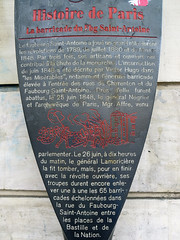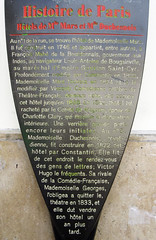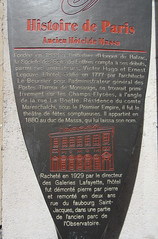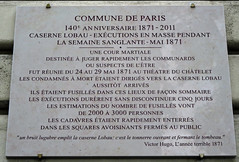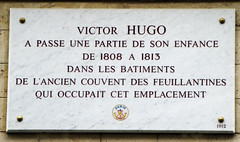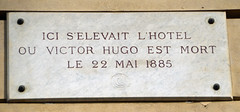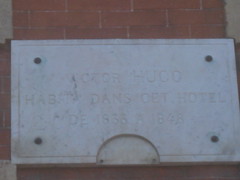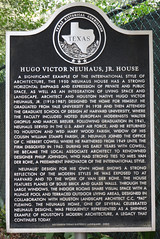Places, subjects, or plaques matching "victor hugo"
1 subject matching "victor hugo"
17 plaques matching "victor hugo"
Café Procope. Ici Procopio dei Coltelli fonda en 1686 le plus ancien café du monde et le plus célèbre centre de la vie littéraire et philosophique au 18e et au 19e siècles. Il fut fréquenté par La Fontaine, Voltaire, les Encyclopédistes, Benjamin Franklin, Danton, Marat, Robespierre, Napoléon Bonaparte, Balzac, Victor Hugo, Gambetta, Verlaine et Anatole France.
English translation: Café Procope. Here Procopio dei Coltelli founded in 1686 the oldest café in the world and the most famous center of philosophical and literary life in the 18th and 19th centuries. It was visited by La Fontaine, Voltaire, Les Encyclopédistes, Benjamin Franklin, Danton, Marat, Robespierre, Napoléon Bonaparte, Balzac, Victor Hugo, Gambetta, Verlaine and Anatole France.
13 rue de l'Ancienne Comédie, Paris, France
Subjects
Texas Historical Marker #05369
The Lay-Bozka House. One of distinctive structures of 19th century Texas. Sometimes called the "Wedding Cake House". Built 1878-1882 by B. J. E. Dietz at cost of $4,750 for Dr. James E. Lay, local physician and Civil War veteran. The architect was Victor Hugo, a French diplomat. Native stone walls are 18 to 24 inches thick. Wood used was cypress. Mansard roof. Windows of variant designs and sizes. Owned and preserved since 1948 by former Mayor M. I. Bozka. Recorded Texas Historic Landmark, 1968 #5369
?, Hallettsville, TX, United States
La barricade du Fbg Saint-Antoine. Le faubourg Saint-Antoine a joué un grand rôle durant les révolutions de 1789, de juillet 1830 et de février 1848. Par trois fois, ses artisans et ouvriers ont contribué à la chute de la monarchie. L'insurrection de juin 1848 a été décrite par Victor Hugo dans "les Misérables", notamment l'énorme barricade élevée à l'entrée des rues de Charenton et du Faubourg-Saint-Antoine. Près d'elle furent abattus, le 25 juin 1848, le général Négrier et l'archevêque de Paris, Mgr Affre, venu parlementer. Le 26 juin, à dis heures du matin, le général Lamoricière la fit tomber, mais, pour en finir avec la révolte ouvrière, ses troupes durent encore enlever une à une les 65 barricades échelonnées dans la rue du Faubourg-Saint-Antoine entre les places de la Bastille et de la Nation.
English translation: The barricade of the Fbg Saint-Antoine. The faubourg Saint-Antoine played a major role during the revolutions of 1789, July 1830, and February 1848. On three occasions, his craftsmen and workers contributed to the fall of the monarchy. The June 1848 insurrection was described by Victor Hugo in the “Miserables”, including the huge barricade raised at the entrance to the streets of Charenton and Faubourg-Saint-Antoine. On 25 June 1848 General Négrier and Archbishop Affre of Paris were shot dead near her. On 26 June, at morning hours, General Lamoricière brought her down, but in order to put an end to the labour revolt, his troops had to remove one at a time the 65 barricades staged on Rue du Faubourg-Saint-Antoine between the places of the Bastille and the Nation. [AWS Translate]
rue de Faubourg Saint Antoine, at the corner of the Place de la Bastille, Paris, France
Hôtels de Mlle Mars et Mlle Duchesnois. Au no. 1 de la rue, se trouve l'hôtel de Mademoiselle Mars. Il fut construit en 1746 et appartint, entre autres, à François Mahé de la Bourdonnais, gouverneur aux Indes, au navigateur Louis-Antoine de Bougainville, au maréchal d'Empire Gouvion Saint-Cyr. Profondément modifié par Constantin en 1822, Mademoiselle Mars l'acheta en 1824 et le fit modifier par Visconti. Comédienne célèbre du Théâtre-Français, devenue riche, elle occupa cet hôtel jusqu'en 1838. En 1840, l'hôtel fut racheté par le Comte de Wagram, époux de Charlotte Clary, qui modifia la décoration intérieure. Une verrière gravée porte encore leurs initiales. Au no. 3, Mademoiselle Duchesnois, tragédienne, fit construire en 1822 cet hôtel par Constantin. Elle fit de cet endroit le rendez-vous des gens de lettres; Victor Hugo le fréquenta. Sa rivale de la Comédie-Française, Mademoiselle Georges, l'obligea a quitter le théatre en 1833, et elle dut vendre son hôtel un an plus tard.
English translation: Hotels of Miss Mars and Miss Duchesnois. At No. 1 of the street is the hotel of Mademoiselle Mars. It was built in 1746 and belonged, among others, to François Mahé de la Bourdonnais, governor of the Indies, to the navigator Louis-Antoine de Bougainville, to the marshal of Empire Gouvion Saint-Cyr. Deeply modified by Constantine in 1822, Mademoiselle Mars bought it in 1824 and had it modified by Visconti. A famous actor of the French Theatre, who became rich, she occupied this hotel until 1838. In 1840 the hotel was bought by the Count of Wagram, husband of Charlotte Clary, who changed the interior decoration. An engraved glass roof still bears their initials. At No. 3, Mademoiselle Duchesnois, a tragedian, had Constantin build this hotel in 1822. She made this place the rendezvous of the letters; Victor Hugo visited him. Her rival of the Comédie-Française, Miss Georges, forced her to leave the theatre in 1833, and she had to sell her hotel a year later. [AWS Translate]
1 rue de la Tour des Dames, Paris, France
Ancien Hôtel de Massa. Fondée en 1838, à l'initiative d'Honoré de Balzac, la Société des Gens de Lettres compta à ses débuts, parmi ses animateurs, Victor Hugo et Ernest Legouvé. L'hôtel, édifié en 1777 par l'architecte Le Boursier pour l'administrateur général des Postes Thiroux de Monsauge, se trouvait primitivement sur les Champs-Elysées, à l'angle de la rue La Boétie. Résidence du comte Mareschalchi, sous le Premier Empire, il fut le théâtre de fêtes somptueuses. Il appartint en 1880 au duc de Massa, qui lui laissa son nom. Racheté en 1929 par le directeur des Galeries Lafayette, l'hôtel fut démonté pierre par pierre et remonté en deux ans rue du faubourg Saint-Jacques, dans une partie de l'ancien parc de l'Observatoire.
English translation: Old Massa Hotel. Founded in 1838, at the initiative of Honoré de Balzac, the Société des Gens de Lettres counted its debut among its animators, Victor Hugo and Ernest Legouvé. The hotel, built in 1777 by the architect Le Boursier for the deputy head of the Post Office Thiroux de Monsauge, was first on the Champs-Elysées, at the corner of Rue La Boétie. The residence of Count Mareschalchi, under the First Empire, was the venue of sumptuous parties. In 1880 he belonged to the Duke of Massa, who left him his name. Repurchased in 1929 by the director of Galeries Lafayette, the hotel was dismantled stone by stone and reassembled in two years on Rue du Faubourg Saint-Jacques, in part of the old park of the Observatory. [AWS Translate]
38 rue du Faubourg Saint Jacques, Paris, France
Hôtel de Laffemas. Messire Isaac de Laffemas (1587-1657) est une créature de Richelieu : d'abord maître des requêtes, puis intendant, il achève sa carrière comme lieutenant criminel et civil, de 1637 à 1643. Dans "Marion Delorme", Victor Hugo insiste sur la sombre réputation de ce personnage : "Démon, j'ai dans tes yeux vu la sinistre flamme de ce rayon d'Enfer qui t'illuminait l'âme !" Disgracié à la mort de son protecteur, il ne cesse pourtant de soutenir le pouvoir, royal en particulier sous la Fronde, d'une plume restée alerte. En effet, "dans toutes les besongnes de haute et basse police, souvent assez malpropres, qu'il accomplit pour le cardinal, il fut toujours soutenu par un dévoument sincère à l'Etat".
English translation: Hotel de Laffemas. Messire Isaac de Laffemas (1587-1657) is a creature of Richelieu: first master of petitions, then intendant, he completed his career as a criminal and civil lieutenant, from 1637 to 1643. In “Marion Delorme”, Victor Hugo emphasizes the dark reputation of this character: “Demon, I have seen in your eyes the sinister flame of this ray of Hell that illuminated your soul!” Disgraced at the death of his protector, he continued to support the power, royal in particular under the Fronde, of a feather that remained alert. Indeed, “in all the cases of high and low police, often quite unclean, that he performs for the cardinal, he was always supported by a sincere dedication to the state”. [AWS Translate]
16 rue Julien Saint le Pauvre, Paris, France
Commune de Paris. 140e anniversaire 1871-2011. Caserne Lobau - Exécutions en masse pendant la semaine sanglante - Mai 1871. Une cour martiale destinée à juger rapidement les Communards ou suspects de l'être fut réunie du 24 au 29 mai 1871 au Théatre du Châtelet. Les condamnés à mort étaient dirigés vers la caserne Lobau. Aussitôt arrivés, ils étaient fusillés dans ces lieux de façon sommaire. Les exécutions durèrent sans discontinuer cinq jours. Les estimations du nombre de fusillés vont de 2000 à 3000 personnes. Les cadavres étaient rapidement enterrés dans les squares avoisinants fermés au public. "un bruit lugubre emplit la caserne Lobau: c'est le tonnerre ouvrant et fermant le tombeau." Victor Hugo, L'année terrible 1871.
English translation: Commune of Paris. 140th anniversary 1871-2011. Lobau Barracks - Mass executions during the bloody week - May 1871. A court martial was held from 24 to 29 May 1871 at the Théâtre du Châtelet to try the Communards or suspects soon. Those sentenced to death were directed to Lobau Barracks. As soon as they arrived, they were shot in these places in a summary manner. The executions continued for five days. Estimates of the number of rifles range from 2000 to 3000 people. The corpses were quickly buried in the surrounding squares closed to the public. “a gloomy noise filled the Lobau barracks: it was the thunder opening and closing the tomb.” Victor Hugo, The terrible year 1871. [AWS Translate]
2 rue de Labou, Paris, France
"Hauteville Fairy" Première maison de Victor Hugo à Guernesey de 1855 à 1856 et demeure de Juliette Drouet à partir de 1864.
English translation: "Hauteville Fairy" First house of Victor Hugo in Guernsey from 1855 to 1856 and home of Juliette Drouet from 1864.
20 rue Hauteville, St. Peter Port, Guernsey
Subjects
Victor Hugo a habite cette maison en 1852
English translation:
Grote Markt 26-27, Brussels, Belgium
Subjects
Dernière demeure de Victor Hugo. En juin 1878, une congestion cérébrale a raison des facultés créatrices du patriarche au faite de sa gloire littéraire et politique. Après des vacances à Guernesey, il s'installe avec Juliette Drouet dans un petit hôtel particulier, loué à la princesse de Lusignan. Le 26 février 1881, l'entrée du poète dans sa 80ème année est célébrée comme une fête nationale, avec arc de triomphe et défilé de six cent mille admirateurs; peu après, l'avenue d'Eylau est rebaptisée de son vivant, insigne honneur, et ses amis peuvent désormais lui écrire: "à monsieur Victor Hugo, en son avenue". Il meurt le 22 mai 1885, victime d'une congestion pulmonaire; à l'heur de l'agonie, un ouragan de tonnerre et de grêle se déchaîne sur Paris. Ses dernières paroles ont été: "Je vois de la lumière noire". En signe de deuil national, le Sénat et la Chambre lèvent leur séance. La nuit du 31 mai, son corps est exposé sous l'Arc de Triomphe et le 1er juin, deux millions de personnes l'escortent en cortège funèbre et triomphal jusqu'au Panthéon, rendu, en son honneur, à sa destination de sépulture des grands hommes.
English translation: Last home of Victor Hugo. In June 1878, a cerebral congestion defeated the creative faculties of the patriarch at the height of his literary and political glory. After a holiday in Guernsey, he moved with Juliette Drouet to a small mansion, rented to the Princess of Lusignan. On February 26, 1881, the entry of the poet in his 80th year is celebrated as a national holiday, with a triumphal arch and a parade of six hundred thousand admirers; soon afterwards, the avenue d'Eylau is renamed during his lifetime, a badge of honour, and his friends can now write to him: "to Monsieur Victor Hugo, in his avenue". He died on May 22, 1885, suffering from pulmonary congestion; at the hour of agony, a hurricane of thunder and hail was unleashed on Paris. His last words were: "I see black light". As a sign of national mourning, the Senate and the House adjourned. The night of May 31, his body was displayed under the Arc de Triomphe and June 1, two million people escorted him in a funeral procession and triumphal to the Pantheon, returned, in his honor, to his burial destination of great men.
124 avenue Victor Hugo, Paris, France
Subjects
Victor Hugo French Poet, Playwright and Author stayed at the Pomme d'Or Hotel on his arrival in Jersey 5th August 1852
Liberation Square, St. Helier, Jersey
Subjects
Victor Hugo a passe une partie de son enfance de 1808 a 1813 dans les batiments de l'ancien Couvent des Feuillantines qui occupait cet emplacement
English translation: Victor Hugo spent part of his childhood in 1808-1813 in the buildings of the former Convent of Feuillantines that occupied this location
8 rue des Feuillantines, Paris, France
Subjects
Ici s'elevait l'hotel ou Victor Hugo est mort le 22 Mai 1885
English translation: Here stood the hotel where Victor Hugo died May 22 1885
124, Avenue Victor-Hugo, Paris, France
Subjects
Victor Hugo habita dans cet hotel de 1833 a 1848
English translation: Victor Hugo lived in this hotel 1833-1848
6 Places Des Vosges, Paris, France
Subjects
Hauteville - House Maison d'exil de Victor Hugo 1856-1870 a été offerte à la ville de Paris par Jeanne Hugo et les enfants de Georges Hugo en MCMXXVII.
English translation: Hauteville House. Victor Hugo's House of Exile 1856-1870 was donated to the city of Paris by Jeanne Hugo and the children of Georges Hugo in MCMXXVII.
38 rue Hauteville, St. Peter Port, Guernsey
Subjects
Texas Historical Marker #12168
John Howland Wood and Nancy Clark Wood House. John Howland Wood (1816-1904) was born in Dutchess County, New York. Trained in the mercantile trade and apprenticed to a painter, Wood enlisted in the New York Battalion to aid the Texas revolution. He arrived in Texas in 1836 in time to participate in the Battle of San Jacinto and several other major events at the close of the war. Wood settled at Victoria as quartermaster of the Texas Army, marrying Nancy Anna Clark in 1842. They became civic and political leaders and the parents of twelve children. The woods moved to St. Mary's, later called Bayside, where they opened a mercantile business and began to acquire vast land holdings throughout the state while John established himself as a cattleman. In 1849 they purchased this property, establishing a ranch which Nancy Wood dubbed "Bonnie View." Lightning damage to the original house led to the construction of this magnificent edifice on its foundations in 1875. Erected by contractors Viggo Kohler and Hugo Heldenfels, the structure combines a typical Greek revival plan with exuberant high Victorian Italianate detailing. The two-tiered, full-height projecting portico supported by Italianate columns establishes the house's imposing character. The house also features pedimented window surrounds, bracketed eaves and a "widow's walk" or "captain's walk," reflecting the architecture of John Wood's native New York. The house's presence on the rural Texas Coast, where few mansions were built, surely impressed visitors and area residents alike during the post-Civil War era. An outstanding example of the Italianate style, it remains one of the area's most substantial and least-altered country mansions of the period. It was listed on the National Register of Historic Places in 1983. Recorded Texas Historic Landmark - 1998 #12168
Copano Bay Blvd. at Wood Ave., Bayside, TX, United States
Texas Historical Marker #13819
Hugo Victor Neuhaus, Jr. House. A significant example of the International style of architecture, the 1950 Neuhaus House has a strong horizontal emphasis and expression of private and public space, as well as an integration of living space and landscape. Architect and Houston native Hugo Victor Neuhaus, Jr. (1915-1987) designed the home for himself. He graduated from Yale University in 1938 and then attended the Graduate School of Design at Harvard University, where the faculty included noted European modernists Walter Gropius and Marcel Breuer. Following graduation in 1941, Neuhaus served in the U.S. Army Air Force, and he returned to Houston and wed Mary Wood Farish, widow of his cousin William Stamps Farish, Jr. Neuhaus joined the office of C. Herbert Cowell where he partnered from 1949 until the firm dissolved in 1962. During his early years with Cowell, he became the local associate architect to renowned designer Philip Johnson, who had strong ties to Mies van der Rohe, a preeminent innovator of the International style. Neuhaus' design for his own home shows a strong reflection of the modern styles he was exposed to at Harvard and to the work of van der Rohe. The house features planes of solid brick and glass walls. Through the large windows, the indoor rooms share visual space with a plunge pool and terraced outdoor living areas, designed in collaboration with Houston landscape architect C.C. "Pat" Fleming. The Neuhaus home, one of several celebrated Neuhaus designs, was frequently represented as a shining example of Houston's modern architecture, a legacy that continues today. Recorded Texas Historic Landmark - 2005 #13819
2910 Lazy Ln, Houston, TX, United States

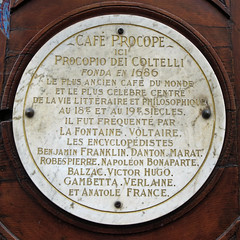

_-001.jpg?width=250)

.jpg?width=250)








